13 Plants that you can easily grow in your balcony and roof:
1. Aloe vera
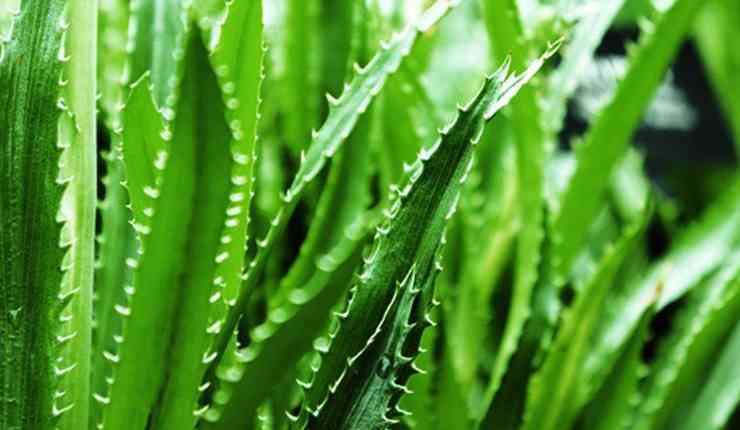 Aloe vera as a succulent is best kept in dry conditions. For soil, it is suggested that you put these in cactus potting soil or just normal soil with building sand. Since it can not grow in conditions of standing or accumulated water, make sure there are plenty of holes in the pot. Let the soil go completely dry before you water them again. Make sure you do not water these plants often. As the most common reason why aloe vera tends to die is due to overwatering. The water should drain freely. An advantage of the aloe vera plant is that it does not require fertilizer or at not as much. If anything, you can fertilize it once a year with a phosphorous based fertilizer.
Aloe vera as a succulent is best kept in dry conditions. For soil, it is suggested that you put these in cactus potting soil or just normal soil with building sand. Since it can not grow in conditions of standing or accumulated water, make sure there are plenty of holes in the pot. Let the soil go completely dry before you water them again. Make sure you do not water these plants often. As the most common reason why aloe vera tends to die is due to overwatering. The water should drain freely. An advantage of the aloe vera plant is that it does not require fertilizer or at not as much. If anything, you can fertilize it once a year with a phosphorous based fertilizer.
The advantages of aloe vera are renowned. Needless to say, this easy to keep plant has the whole bunch of benefits starting with beauty and ending with medicinal uses. It can cure the wound, acting as a toner, ease sunburn, and has antibacterial properties.
You might also be interested in getting the spa experience at home which we have written in detail in the article Spa At Home: How To Get A Spa Treatment At Home.
2. Periwinkle
 Perwinkle plant is best grown in moist soil and under the sun. That being said, it can grow under a variety of conditions like shade, clay and alkaline soil and under drought conditions. If you want a plant to grow on the slope or to prevent erosion, Periwinkle plant is it! Try not to grow it with other plants because it has dense fibrous roots which take up a whole bunch of space. If you have to, keep a distance of 30.48 centimetres to 45.72 cm Rather than going for seeds, use the stem of the plant to grow it. Use manure, compost and peat moss for better drainage.
Perwinkle plant is best grown in moist soil and under the sun. That being said, it can grow under a variety of conditions like shade, clay and alkaline soil and under drought conditions. If you want a plant to grow on the slope or to prevent erosion, Periwinkle plant is it! Try not to grow it with other plants because it has dense fibrous roots which take up a whole bunch of space. If you have to, keep a distance of 30.48 centimetres to 45.72 cm Rather than going for seeds, use the stem of the plant to grow it. Use manure, compost and peat moss for better drainage.
Plant these during spring of fall. After which, water it well. And for the first few weeks, keep the soil moist. If you keep removing weeds and keep the soil well-drained, the chances of pests and other diseases get reduced. Perwinkle is an invasive species. Once it becomes established, the plant is difficult to get rid of. So make sure you plant it in an appropriate area.
3. Datura
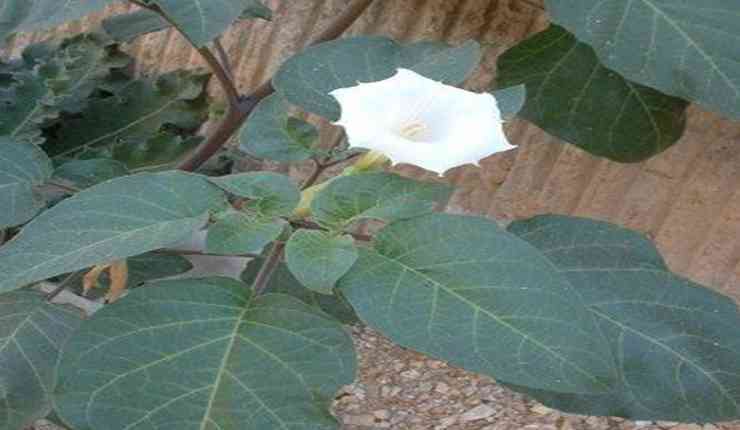 Datura plant grows as tall as 4 feet and that also, very quickly. These are relatively easy to grow with the help of seeds. The flowers smell sweet, especially during the night. That being said, these flowers are poisonous and are an aphrodisiac. These are autogamous plants. Hence, ensuring that they grow year after year without human intervention. They simply require sun, water and fertile, well-drained soil. Plant it in any season apart from winter. Like, maybe, fall or spring.
Datura plant grows as tall as 4 feet and that also, very quickly. These are relatively easy to grow with the help of seeds. The flowers smell sweet, especially during the night. That being said, these flowers are poisonous and are an aphrodisiac. These are autogamous plants. Hence, ensuring that they grow year after year without human intervention. They simply require sun, water and fertile, well-drained soil. Plant it in any season apart from winter. Like, maybe, fall or spring.
The seeds are easy to maintain. If you notice, that the flowers are drooping, it is likely because they are not getting an adequate amount of moisture. If you are growing Datura in pots, you will have to re-pot them annually. During winter, they might lose leaves but they grow back during the summer season. You might consider moving them inside during colder climates or put in a place with adequate sunlight. If the plant grows beyond your ken, you can consider staking.
4. Cactus
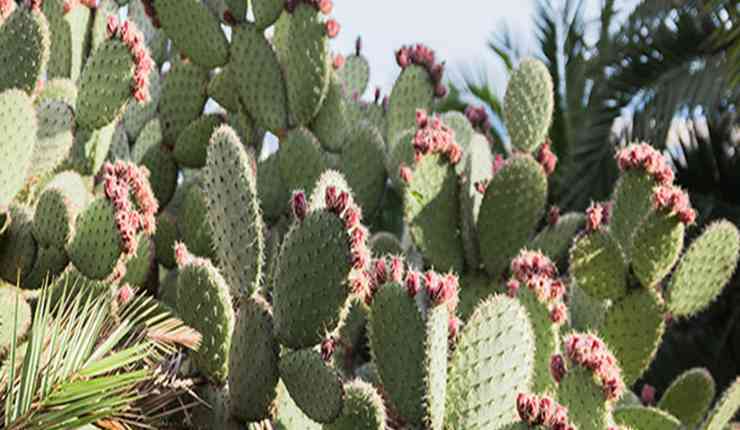 Cactus are dessert plants that thrive under arid conditions. But these are also amazing indoor plants! And you might have seen them in interior magazines or on Tumblr. These are valued a lot for their aesthetic, fuss-free existence. To grow them, cut off a stem from a healthy cactus plant. Keep the cut stem under the sun for two days. If you do not let the wound heal, the stem will most likely end up rotting. Choose a pot with lots of holes that will allow an excess of water to drain out. Also, choose a soil that will drain well.
Cactus are dessert plants that thrive under arid conditions. But these are also amazing indoor plants! And you might have seen them in interior magazines or on Tumblr. These are valued a lot for their aesthetic, fuss-free existence. To grow them, cut off a stem from a healthy cactus plant. Keep the cut stem under the sun for two days. If you do not let the wound heal, the stem will most likely end up rotting. Choose a pot with lots of holes that will allow an excess of water to drain out. Also, choose a soil that will drain well.
Online, you might come across cactus specific potting soil. Mix this with perlite or lava rock pebbles. Again, both of these can easily be found online. Moisten the soil after you have planted the stem. Make sure not to soak the soil. Consider a spray bottle if you are unsure. Do this only when you feel or think that the soil is dry. Keep it in an area where there is a lot of bright and indirect sunlight.
5. Money plant
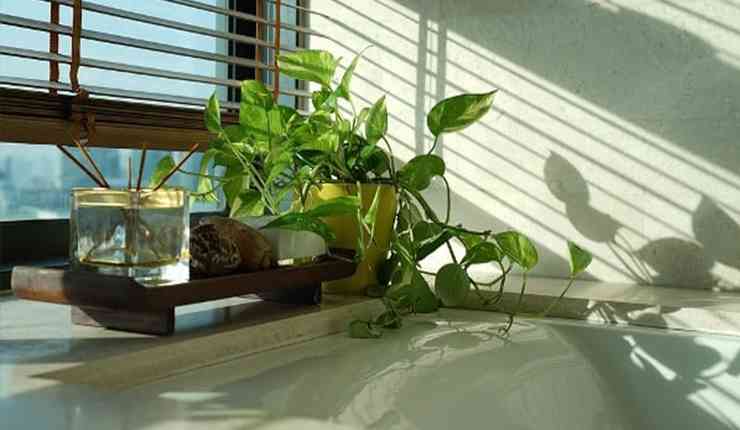 Money plant in India is considered as a source of luck and fortune. It grows well in temperate conditions. Once can propagate it through stem cuttings. Just place the cutting in a container filled with water for a few weeks. When you begin to see hints of root developing, keep it in another container filled with soil. If you want to grow money plant in water, choose a glass jar. If you wish to grow it in soil, choose a medium-sized pot with a good drainage system. And then place a saucer under the pot.
Money plant in India is considered as a source of luck and fortune. It grows well in temperate conditions. Once can propagate it through stem cuttings. Just place the cutting in a container filled with water for a few weeks. When you begin to see hints of root developing, keep it in another container filled with soil. If you want to grow money plant in water, choose a glass jar. If you wish to grow it in soil, choose a medium-sized pot with a good drainage system. And then place a saucer under the pot.
If you are going to grow the money plant in jelly, use a glass jar. Being a temperate plant, it can deal with a variety of conditions except for winter. It can grow well in a wide variety of soil but the best is loamy soil at a pH of 6.0 to 7.5. Both direct or indirect sunlight works for money plant but not too much sunlight. Keep it sun for only two to four hours. Use sand as potting soil. Money plant likes humidity so dry the soil between watering sessions. Do not overwater the plant unless you want the root to rot. If the roots emerge out of the pot, it is time you prune or change the pot. Repot the plant every two years or so.
6. Spider Plant
 Spider plants get their name from the offsets (or pups) they produce during the summer season. NASSA has acknowledged its air-purifying properties. And they look really elegant when put in a hanging pot. These plants like the soil to be in between; neither too dry nor too wet. Keep Spider Plants in moderate to indirect sunlight. Otherwise, their leaves would burn and brown spots would develop on them. You might have to change pots every year or so because they grow very fast.
Spider plants get their name from the offsets (or pups) they produce during the summer season. NASSA has acknowledged its air-purifying properties. And they look really elegant when put in a hanging pot. These plants like the soil to be in between; neither too dry nor too wet. Keep Spider Plants in moderate to indirect sunlight. Otherwise, their leaves would burn and brown spots would develop on them. You might have to change pots every year or so because they grow very fast.
During initial growth, you will have to water them occasionally. But after they have become established, reel back a little and water them to in a moderate amount. Try not to let the soil dry though. These plants work best in moist conditions. Fertilization should be done twice a month (but not more) during spring or summer. If you want more spider plants, you can use the pups (or offsets) which have reached 5.08 cm in size and plant it. Or keep the still attached pup into a nearby pot filled with soil. Once they have established themselves, feel free to detach them from their mother.
7. Marigold
 Marigold is the perfect fuss-free plant to grow for any novice. And it helps that they come in such pretty colours. These plants grow in a lot of soil and climates, especially suitable for the raging heat of Indian weather. They also come in different sizes like small, tall and giants. It acts as a pest repellent so just in case, if you grow vegetables, consider plants marigold around to keep the pests at bay.
Marigold is the perfect fuss-free plant to grow for any novice. And it helps that they come in such pretty colours. These plants grow in a lot of soil and climates, especially suitable for the raging heat of Indian weather. They also come in different sizes like small, tall and giants. It acts as a pest repellent so just in case, if you grow vegetables, consider plants marigold around to keep the pests at bay.
The plant is much before winter or after the winter season. They require full sun so keep it at a strategic place where lots of sunlight reach. If that is not possible in your balcony, consider investing in some grow lights. You will have to water it regularly. For compost, go organic or well-aged manure. The soil should be moist. That does not mean it should be wet all day round. Sow the seeds and then cover it with a layer of soil. After which, water it. Keep the plants 20.32 cm to 45.72 cm apart.
8. Snake plant
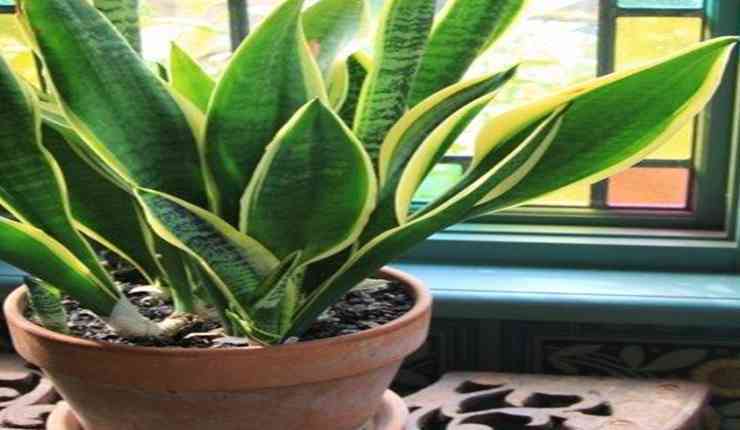 If you are not sure whether a growing plant is your thing not. If you are unsure if you have a green thumb or not. If you are just not someone who would commit to something that will require long term dedication. Then Snake plant is the best option. It is the flag bearer of pluckiness among plants. Ignore it for a while and it would continue to grow, determined like a spider.
If you are not sure whether a growing plant is your thing not. If you are unsure if you have a green thumb or not. If you are just not someone who would commit to something that will require long term dedication. Then Snake plant is the best option. It is the flag bearer of pluckiness among plants. Ignore it for a while and it would continue to grow, determined like a spider.
They can survive low light conditions, drought and can survive through a lot of insect attacks. These also keep the air clean by removing formaldehyde and benzene. You can grow it from leaf cuttings in free-draining soil. The easiest method is dividing. Let the root produce rhizome, remove it and pot it. Now put them under indirect sunlight with just a little amount of water.
You might also be interested in knowing the Amazing Facts About Sharks Showing How Incredible They Are.
9. Snapdragon
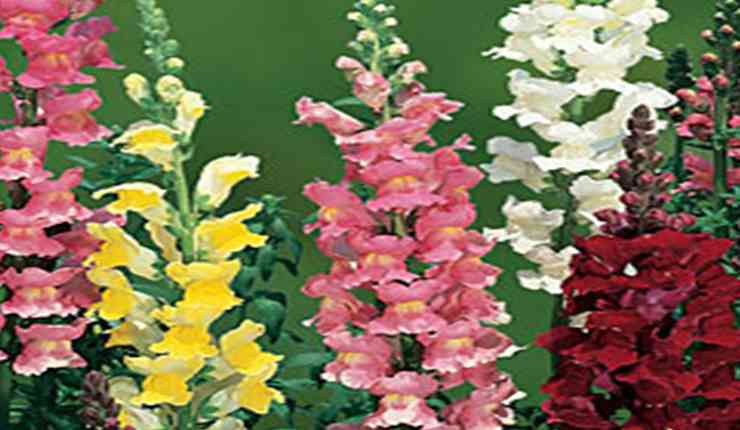 You can grow snapdragon from seeds. These prefer cooler and moist soil. Once the seedlings emerge out of the soil, keep them in sun. Note that the seeds need to be kept in indirect sunlight. They do require some dark period to grow though. To prevent apical dominance, prune the top parts as the snapdragon continues to grow. They do require much fertilizer. Just half a starter solution is enough for them. The soil should be rich in minerals, moist, organic and well-drained.
You can grow snapdragon from seeds. These prefer cooler and moist soil. Once the seedlings emerge out of the soil, keep them in sun. Note that the seeds need to be kept in indirect sunlight. They do require some dark period to grow though. To prevent apical dominance, prune the top parts as the snapdragon continues to grow. They do require much fertilizer. Just half a starter solution is enough for them. The soil should be rich in minerals, moist, organic and well-drained.
There should be no grass or rocks in the soil. Compost will help the plant grow well and you can do this at any time of the day. Make sure no weeds are growing around the plant as they compete with plants for nutrition and water. The plants should 30.48 cm apart. Until the plant grows, keep it protected from wind and direct sunlight. Snapdragons produce flowers during winter. So they are a great option to add colour to your garden during the cooler months. While taller plants are long-lasting, you would have to consider stake them.
10. Peace Lily
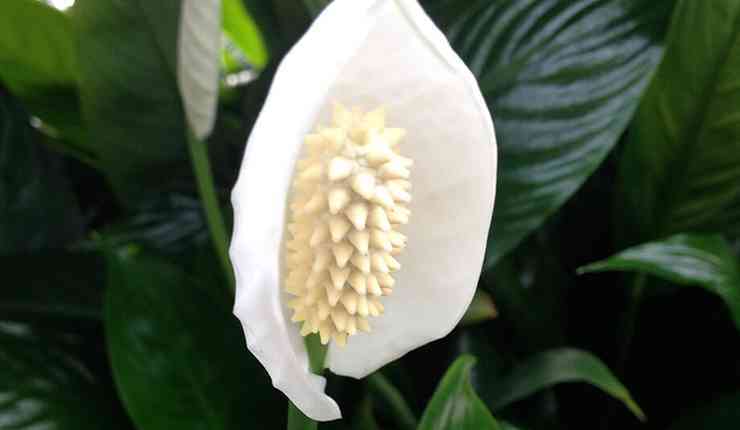 Peace lilies prefer warm, humid conditions. So keep it under indirect sunlight. They should not be exposed to cold air or too much sunlight. When you find the soil dry, water it enough to turn it damp. Consider watering it once a week or when you find the soil is dry. If you feel unsure, water it when you think the leaves are starting to wilt.
Peace lilies prefer warm, humid conditions. So keep it under indirect sunlight. They should not be exposed to cold air or too much sunlight. When you find the soil dry, water it enough to turn it damp. Consider watering it once a week or when you find the soil is dry. If you feel unsure, water it when you think the leaves are starting to wilt.
While these do not require pruning, do remove the unhealthy leaves. If you want to fertilize, use a 20-20-20 plant fertilizer at one half of the recommended strength in summer. If the plant becomes too big for the pot, you would have to report it. Repotting of peace lily should be done one or two years. For soil, go for a peat-based one which has composted bark with no odour.
Love travelling? Here are the Top 10 Watery Wonders Of The World That Will Create Astound You.
11. Lavender
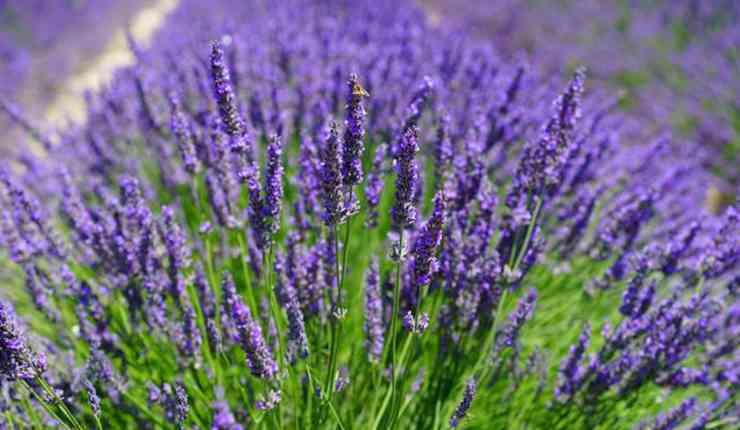 Lavender is valued for its fragrance, attracting pollinators, insect repelling properties and the beautiful colour. Plant lavender during the spring. Keep them 60.96 cm to 91.44 cm apart. The soil should be moderately fertile. Add some organic matter to improve drainage.
Lavender is valued for its fragrance, attracting pollinators, insect repelling properties and the beautiful colour. Plant lavender during the spring. Keep them 60.96 cm to 91.44 cm apart. The soil should be moderately fertile. Add some organic matter to improve drainage.
These do not prefer moist, wet areas. Consider using rocks to keep weeds away. You have to water it once or twice until the plants have established themselves. After which you will have to water them every two to three week. And when buds appear, water them once or twice weekly.
12. Azalea
 Azalea is relatively easy to take care of. But they are best when planted alone. Plant them in spring in an area with medium sunlight to prevent burning or poor blooming. They require well-drained, acidic soil. Add compost to the soil beforehand.
Azalea is relatively easy to take care of. But they are best when planted alone. Plant them in spring in an area with medium sunlight to prevent burning or poor blooming. They require well-drained, acidic soil. Add compost to the soil beforehand.
To prevent weed, add pine straws as mulch. If you add organic matter and mulch, frequent fertilization will not be required. Make sure the soil is rich in nitrogen, though. Once the blooming period has expired, trim these plants.
13. Weeping Fig
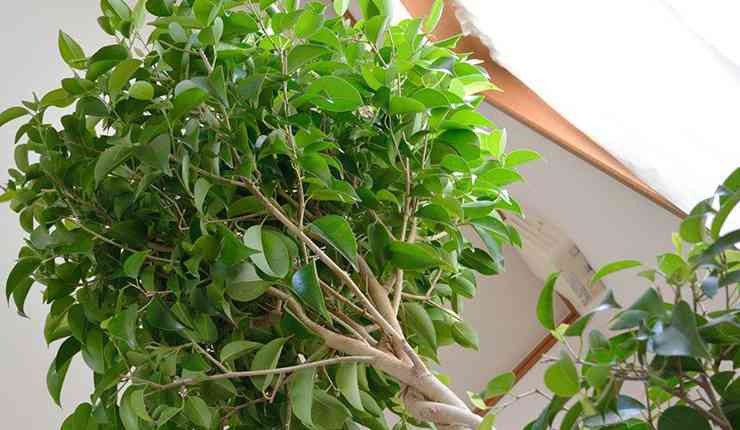 The weeping tree is a widely popular house plant and is also seen in offices. It has the ability to tolerate low light conditions. You will have to keep pruning these. You can braid the trunks for decoration. The leaves are shed when they are under stressful conditions. These are great at improving the quality of air. It removes toxins like formaldehyde, benzene and trichloroethylene. Fill the container with soil and keep under bright, indirect sunlight. These need to be regularly watered while growing.
The weeping tree is a widely popular house plant and is also seen in offices. It has the ability to tolerate low light conditions. You will have to keep pruning these. You can braid the trunks for decoration. The leaves are shed when they are under stressful conditions. These are great at improving the quality of air. It removes toxins like formaldehyde, benzene and trichloroethylene. Fill the container with soil and keep under bright, indirect sunlight. These need to be regularly watered while growing.
It does not like to be moved from here and there. So allocate a specific, permanent place. For soil, go for a well-drained one. While repotting, add perlite, sand and vermiculite. Weeping fig needs to be kept in moist condition but standing water. The watering schedule should be strictly followed.


